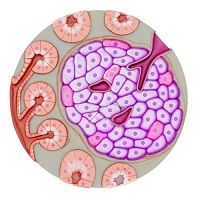Article
Urban African Americans Get Pancreatic Cancer Much Younger, Study Finds
Author(s):
Pancreatic cancer is a difficult disease to treat successfully. For urban African Americans, that picture may be even worse, a Georgia researcher and colleagues found. Their report, subtitled "Too Young, Too Late" was presented today at the American College of Gastroenterology Scientific Meeting in Honolulu.

Few people live more than a year with pancreatic cancer. The outlook appears even worse for urban African Americans, Saurabh Chawla, MD, director of interventional endoscopy at Grady Memorial Hospital in Atlanta, GA reported today at the American College of Gastroenterology Scientific meeting in Honolulu.
In a study of pancreatic cancer patients at his hospital, Chawla found that African Americans tended to come to the hospital with stage 4 pancreatic cancer, to choose not to get treatment, and to be significantly younger than patients nationally. While the median age for onset of the disease nationally is 71, Chawla’s study found the average age of his patients was 60, and some were struck with the disease in their 30’s. They had risk factors including smoking (65%), drinking (54%) and were four times more likely to have diabetes than patients in a national database. “It could be environmental, or a matter of genetics,” he said.
The fact that 60% of the patients did not come back for follow-up care was particularly upsetting, he said in an interview after the presentation.
Grady is a ‘safety net’ hospital, one that treats all regardless of ability to pay. So when patients got their diagnosis, physicians made up treatment plans and expected that patients would want treatment. Most did not, he said. “They would have gotten radiation, chemotherapy, surgery. Why they didn’t come back, we don’t know—it was eye-opening for us.” Perhaps it is “a deep distrust” of medical care, he said.
The most surprising thing in the study was the young age of patients, but Chawla said he had seen a similar phenomenon in his training days in a hospital in Chicago. Again, his African American patients appeared to get pancreatic cancer younger.
When he came to Grady and saw a similar pattern, he decided to do the study, he said. The cases can be very sad, he added. “I remember a gentleman in his early 40s with ittle kids and a young wife, a man who ran a store who presented with jaundice.” The man had pancreatic cancer and died of complications within six months. “It is a difficult disease to cure,” Chawla said.
Since the study was based solely on patients in Atlanta, Chawla next hopes to look at comparable data in other cities and nationally. He also wants to look at tumor characteristics.





